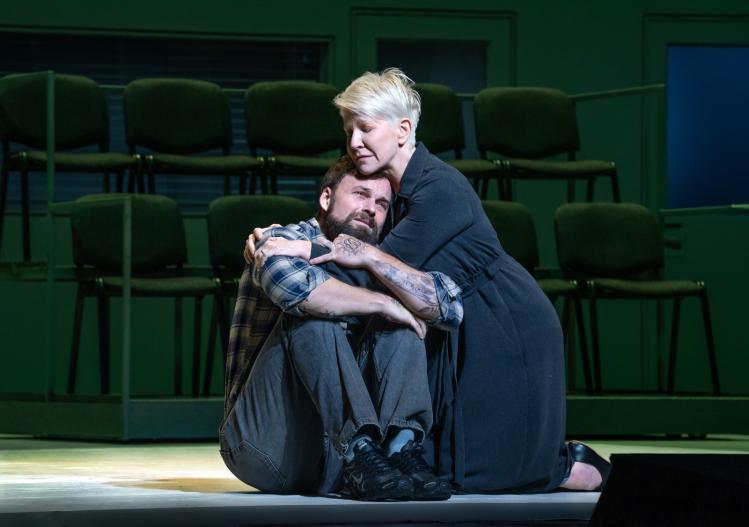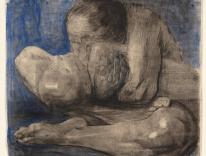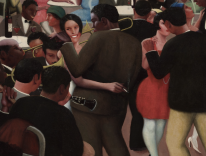
It’s been thirty years since the publication of Dead Man Walking, Sr. Helen Prejean’s bestselling memoir about her ministry to two Louisiana men on Angola’s death row in the 1980s. The crimes of Elmo Patrick Sonnier and Robert Lee Willie—abduction, rape, and murder—were indeed awful. Even so, Prejean argued, the state had no right to kill them. In simple prose shorn of pieties, she textured her own wrenching encounters with the killers and the parents of their victims with lucid writing on history, sociology, constitutional law, philosophy, and theology, building a persuasive case for the abolition of capital punishment in the United States. Prejean’s book instantly made her a public figure; her advocacy paid off, inspiring a generation of American Catholics to embrace nonviolence and influencing Pope Francis’s 2018 modification of the Catechism that declared the death penalty “inadmissible” in all cases. (Her work remains urgent; though down from its peak of 80 percent in the mid-nineties, public support for the death penalty in this country remains at a disconcertingly high 55 percent.)
The story of Dead Man Walking also resonated with wider audiences. In 1995, it was adapted into an award-winning film by Tim Robbins, starring Susan Sarandon as Sr. Helen and Sean Penn as the convicted murderer Matthew Poncelet, a composite character based on Sonnier and Willie. (Robbins’s screenplay wisely shifted the method of execution from the electric chair to lethal injection, inviting audiences to consider whether such a killing, which imitates a medical procedure, could ever be considered “humane.”) Then in 2000, Dead Man Walking became an opera, the result of a collaboration between veteran playwright Terrence McNally and first-time composer Jake Heggie. Since its premiere at the War Memorial Opera House in San Francisco, Dead Man Walking has received close to eighty productions and hundreds of performances around the world. (It even caught the attention of Commonweal, whose critic reviewed it favorably in 2002.) Now, more than two decades later, Dead Man Walking has at last arrived at the Metropolitan Opera in New York, where it opened the 2023–24 season in late September. The powerful new production, directed by Ivo van Hove and conducted by Yannick Nézet-Séguin, will enjoy a month-long run at the Met, culminating in a Live-in-HD broadcast screened in cinemas around the world on October 21. (It will then be available for streaming on the Met website.)
Opera can be synonymous with excess, but McNally’s libretto (which borrows much of its structure from Robbins’s screenplay) is economical, moving briskly from Sr. Helen’s work at Hope House in the New Orleans projects to Angola’s Death Row, then on to the Pardon Board and finally to the execution chamber. We’ve barely been introduced to Sr. Helen (voiced by mezzo-soprano Joyce DiDonato, who sports a shock of short blonde hair and a modest gray habit) before she makes the “long, hot drive” to the visiting room at Angola after receiving a letter from Prisoner 95281, Joseph DeRocher (bass-baritone Ryan McKinny). Despite Joe’s charisma (“It was good of you to come, Sister,” he croons while lighting a cigarette) and his protestations of innocence (“My brother killed those two kids”), we know from a graphic film projected during the overture that he’s guilty. Muscled and tattooed, often defiant and full of rage, Joe nevertheless admits that he’s scared: “I’m frightened of what they’re gonna do to me…that the humaneness of lethal injection is gonna hurt like fuckin’ hell.” His fear provides an opening and a point of connection for Sr. Helen, who shares his sense of abandonment: “Who will walk with me?… My journey is terrible, too,” she laments. Outwardly, as Joe’s spiritual adviser, she challenges him to admit his guilt, claiming that “the truth will set you free”; inwardly, she struggles to find the forgiveness she preaches and that her faith demands.
These are complex emotions, and van Hove’s exceedingly spare staging gives Helen and Joe the literal space to work through them together. Van Hove is known for minimalism, but in Dead Man Walking he pushes the austerity even further, dispensing with almost all traces of realism, including bars and cuffs. The set, designed by Jan Versweyveld, is little more than an empty cube, its flat gray surfaces punctuated by a few narrow windows and sliding doors. (There’s also a retractable hoop, which appears during a prison basketball game that quickly devolves into a brawl.) Though visually as unappealing as it gets, the set compellingly recreates the chilling emptiness—and the attendant psychological disorientation—of death row: “It’s surreal, all of it,” Prejean wrote. “My mind keeps casting for something to reassure itself…that this is all a bad dream.”
Paradoxically, this barrenness enables DiDonato and McKinny to access a deeper, fuller level of intimacy on stage. In reality, Prejean had only ever visited Sonnier and Willie through bars and screens, while the men’s hands remained shackled to their waists. But here Joe and Sr. Helen orbit each other in a kind of dance, sometimes drifting closer, sometimes pushing further apart, occasionally sitting next to each other on the floor. (A comic interlude in Act II shows the pair standing up and gyrating to the music of Elvis Presley.) Physical touch—impossible under the regulations of the actual Angola—here becomes integral to Dead Man Walking’s dramaturgy, and forms the core of its theology of mercy: “God’s love and forgiveness are of precious little consolation / if we do not feel it for our fellow man…. Forgiveness is in the smallest gesture…the touch of a hand, a look, or a smile,” explains Sr. Rose (soprano Latonia Moore), a member of Sr. Helen’s religious community, who acts as both her foil and confidante.
These gestures often pack an uncanny emotional charge, as if DiDonato and McKinny aren’t acting, but actually living a real experience of communion. Both have stated that working on previous productions of Dead Man Walking changed their lives: DiDonato regularly volunteers in prison music programs (she helped stage a performance of the opera at New York’s Sing Sing prison, where inmates sang in the chorus), while in recent years McKinny befriended a death-row inmate, Terrence Andrus, first by writing letters and then visiting him regularly in a Texas prison. Following the Supreme Court’s decline to hear his appeal, Andrus took his own life earlier this year. In a recent social media post, McKinny explained that he asked the Met’s costume department to design a tattoo in the shape of a black rose, which he wears on the back of his hand during performances in memory of a poem Andrus had written.
Details like this would usually be imperceptible to operagoers, except that Dead Man Walking makes ample and effective use of live video (another distinctive Van Hove device). Clad in all black, filmmakers regularly appear with the singers on stage; like a high-tech pair of opera glasses, their cameras feed detailed close-ups to a boxy screen that hovers above the set. In part, this evokes the voyeuristic exoticism and brutality of prison documentaries; but it also recalls the video art of figures like Bill Viola, in which the camera becomes an eye capable of penetrating the depths of the human psyche.
One particularly compelling example occurs at the opening of Act II. A split-screen video juxtaposes Sr. Helen’s twitchy facial expressions as she sleeps fitfully on the left with the tension and pain in Joe’s arms and eyes as he powers through a set of pushups on the right. It’s a distressing dual image of confinement and separation, heightened by the relative proximity of the two actors on stage. Far more disturbing, though, is when Joe is at last strapped to the cruciform gurney. The scene unfolds in complete silence; Sr. Helen kneels as the camera zeroes in on the needle just before it is inserted by a “medical” team into Joe’s arm. As in actual executions, the whole scene is chillingly choreographed. It’s as if this killing—filmed right in front of us, with Joe’s pained face projected above—is really taking place.
In some sense, Dead Man Walking, which ends with Joe’s death at the hands of the state, follows the classic structure of operatic tragedy. Both protagonists are powerless to change Joe’s fate, as indifferent official forces—there’s the Church, represented by Fr. Grenville, who leads a hauntingly impersonal Our Father, and the State, depicted in the jovial figure of Warden Benton, whose officers chant pro-death-penalty platitudes like “an eye for an eye…the Bible demands it”—conspire to separate them. Nothing, not even the dignified pleading of Joe’s mother (mezzo-soprano Susan Graham) can stop the inexorable march of the “death machine,” which demands constant sacrifice. Musically, Heggie captures this in a devastating sextet sung by the families of Joe’s victims: “You don’t know what it’s like,” runs their reproach to Sr. Helen, whose stream of apologies is cut short by the parents’ mechanical repetition of the last words they spoke to their children (“shut the door…fix your hair…clean your room”). In another classic operatic device, delivered at the end of Act I, Helen faints, unable to seize on any harmony amid a swirling storm of sound.
But Dead Man Walking is also, as DiDonato suggested at a recent talk at Fordham’s Center on Religion and Culture, a “love story, one of the greatest in all of opera.” It’s actually multiple love stories: there’s the unlikely friendship between Sr. Helen and Joe, of course, but also the love of Joe’s mother for her son, Sr. Helen’s love for “my God…my Jesus.” There is also God’s love for Joe, experienced not just in the person of Sr. Helen, but in Joe’s ultimate capacity to forgive himself and to ask forgiveness from the parents of his victims. Heggie’s genius is to have composed a single, simple prayer, based on traditional American spirituals, in which all of these loves interact: “He will gather us around / all around / by and by / you and I / all around Him.”
The hymn, which is also Sr. Helen’s leitmotif, opens and closes Dead Man Walking and serves as a musical throughline. Depending on the scene, it’s a teaching tool, defense mechanism, theological abstraction, or desperate petitionary prayer invoked by Sr. Helen whenever she feels uneasy. Only after Joe’s execution does the song, voiced a cappella and through tears, truly become a form of testimony, both a firm declaration of hope (“He will gather us around”) and evidence of an irreversible inner transformation (“you and I”). That transformation is rooted, above all else, in a comfort with paradox: Sr. Helen knows that yes, Joe really did commit those horrible crimes, and yes, those kids really aren’t coming back; not even Joe’s death can erase their parents’ grief. But also and in some sense even more true is the fact that Joe is a “son of God,” worthy through the sheer fact of his existence of love, mercy, and redemption. The mystery does not need to be understood to be accepted and revered. The murderer, too, will be among those gathered “all around Him” in the end.
At the same Fordham talk, DiDonato said that she used to find that final aria nearly impossible to sing after the execution scene. Watching her deliver it is the sonic equivalent of watching a person pick up a bus with her bare hands, lifting the emotional weight of the cast, orchestra, and thousands of spectators with the unamplified reverberations of her body. She channels a communal feeling with a force beyond words.
As DiDonato sang Sr. Helen’s final aria on opening night, I doubted whether the star-studded, champagne-sipping gala audience had gotten it. Did Sr. Helen’s unabashed love for God—and her practice of chastity, poverty, and obedience—really resonate? But as the curtain fell and the subsequent standing ovation wore on, I noticed crumpled tissues all over the floor. The crowd applauded even more wildly as Prejean herself, dressed in a simple black suit with a red and white scarf, walked out onto the stage. I had the sense that what was being celebrated wasn’t necessarily her, or her book, or even the opera itself. It was the courage she’d had in leaving the relative comfort and safety of the convent to travel to those “spaces of suffering only God can know.” For an evening, Heggie, DiDonato, and McKinny had taken us there, making us feel like we’d been changed, too.
Please email comments to [email protected] and join the conversation on our Facebook page.
Previous Story
Devastation in Libya
Next Story
The Bible as Poetry


